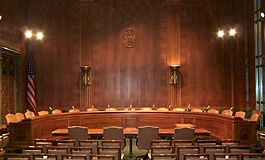| Standing committee | |
|---|---|
Active United States Senate 118th Congress | |
| History | |
| Formed | December 10, 1816 |
| Leadership | |
| Chair | Dick Durbin (D) Since February 3, 2021 |
| Ranking member | Lindsey Graham (R) Since January 3, 2023 |
| Structure | |
| Seats | 21 members |
| Political parties | Majority (11)
|
| Jurisdiction | |
| Policy areas | Federal judiciary, civil procedure, criminal procedure, civil liberties, copyrights, patents, trademarks, naturalization, constitutional amendments, congressional apportionment, state and territorial boundary lines |
| Oversight authority | Department of Justice, Department of Homeland Security, federal judicial nominations |
| House counterpart | House Committee on the Judiciary |
| Meeting place | |
| 226 Dirksen Senate Office Building, Washington, D.C. | |
 | |
| Website | |
| judiciary.senate.gov | |
| Rules | |

The United States Senate Committee on the Judiciary, informally known as the Senate Judiciary Committee, is a standing committee of 21 U.S. senators[1] whose role is to oversee the Department of Justice (DOJ), consider executive and judicial nominations, and review pending legislation.[2][3]
In addition, the Standing Rules of the Senate confer jurisdiction to the Senate Judiciary Committee in certain areas, such as considering proposed constitutional amendments and legislation related to federal criminal law, human rights law, immigration, intellectual property, antitrust law, and internet privacy.[2][4]
- ^ U.S. Senate: Committee on the Judiciary -- Committee Membership List
- ^ a b "Jurisdiction". United States Senate Committee on the Judiciary. Retrieved January 11, 2018.
- ^ "Senate Committee on the Judiciary". GovTrack. Retrieved January 11, 2018.
- ^ "Guide to Senate Records: Chapter 13 Judiciary 1947-1968". National Archives. August 15, 2016. Archived from the original on April 8, 2017. Retrieved April 7, 2017.